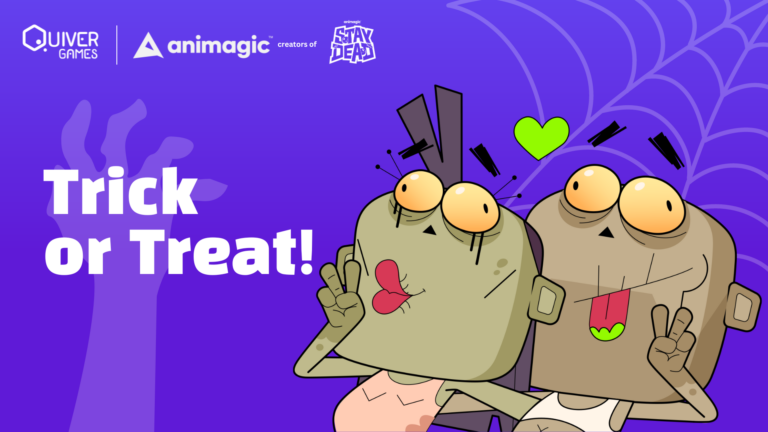1 year of development: Stay Dead's journey
Vancouver, BC. Canada
This is Stay Dead 1 year of game development. Despite being a small group, passion, creativity, and hard work have brought something truly unique to the gaming world. As we sit down with the dev team, we dive into their experiences, challenges, and the journey of bringing “Stay Dead” to life, all within an impressively short timeframe of just 12 months. And yes, one of our key developers is only 17 years old!
The Spark That Ignited the Fire
1. What inspired you to pursue games as indie developers? What motivated you to start?
Animagic has primarily focused on animation for several years, developing our own short films and creative advertisements. However, our transition into game development unfolded naturally. The concept of merging talents to create an interactive format that turns players into protagonists of a unique experience captivated me. Our confidence to delve into this new arena was bolstered by the chance to develop three games alongside Discord. Collaborating and experimenting closely with them fueled our curiosity and marked our first step toward embarking on such a project. As we started experimenting, creativity flowed, and the results were very motivating. – Jordi Ayguasenosa (Co-Director)
The Building Blocks
2. What programming languages and tools did you use for your first game?
We mostly used Unity for game development. Although we considered Unreal for a few weeks, we ultimately chose Unity because its style better aligns with what Animagic already does. Visually, it was easier for us to achieve our design and lighting styles. Additionally, Unity offered us more accessible programming for our experience, as we can program in C#.
For creating 3D elements, we used Blender for modeling and rigging characters. This choice was due to how easily it integrates with other programs. As for designing the user interface (UI), we mainly used the Adobe suite, with Substance for texturing elements. – Emilio Treviño (Developer)
Overcoming the Odds
3. What were some of the biggest challenges you've faced? How did you overcome those challenges?
Optimizing the game for mobile devices presents unique challenges compared to consoles or computers because the variety of devices and their capabilities vary widely. It’s crucial that the game is lightweight and runs quickly on any device to ensure a smooth experience for all users. During the development of our first mobile game, we faced the task of discovering and solving these optimization challenges continuously.
This experience has allowed us to learn in detail about the complexities of mobile development and has improved our overall understanding of the game development process.
We’re all about diving headfirst into research and experimentation. From crafting intricate levels to nailing down those collider mechanics, we’re constantly on the lookout for creative solutions. Sometimes, the best ideas hit me when I least expect it—like in the middle of a dream or when I’m chilling away from the computer. It’s all part of the thrill of pushing our game to new heights! – Emilio
When it came to the floor shaders, we ran into a problem when we activated the large file system on GitHub. Our license only gave us 2 GB of space, but in no time, we ended up using up to 20 GB in a single day! Faced with this situation, we had to come up with a quick solution. We decided to simplify the floor design and turn it into a texture instead of a shader. And it worked! This allowed us to drastically reduce the space needed and keep our project running smoothly. – David Parra (developer)

Laughter, Lessons and Moments of Triumph
4. Can you share any funny, joyous, or proud moments from your development journey?
When we introduced (the dog) Hades’ ability, we soon discovered a problem: without a cooldown, players could repeatedly use the “dig” ability at any point in the game. This allowed them to bypass enemies and effortlessly reach the final goal, essentially bypassing the carefully crafted game mechanics and skill-learning process we had designed. It was a bit absurd, but we quickly implemented a cooldown feature to address the issue. Thankfully, that fixed the problem! 😄-David
A moment that stands out for me is how we clandestinely organized the creation of the demo. The director of Animagic was unaware that we were working on a prototype, so we decided to start development on our own to prove to ourselves that we could take this step. It was a revealing moment that showed us that we could really carry the project forward.
Another significant moment was when I had to learn to write shaders in HLSL. Although I had no previous experience in this language, in a week, I managed to write 3000 lines of code and create the shader. This achievement made me realize that I had the ability to develop a game and was a turning point in my confidence and skills. – Emilio
In December, we set out to finish the game prototype, which represented another step towards the reality of the project. We worked quickly and managed to showcase the game at the Game Developers Conference (GDC) with a version available for the first release outside of Animagic. It was exciting to see the positive reaction of people to the IP, and our booth was always filled with interested visitors. -Jordi

Anticipation and Hope
5. What emotions are you currently experiencing as you prepare to launch your debut game into the world?
Stress is part of the process, right? HAHA Seeing how people react to the game is incredibly rewarding after so much effort. Development can be challenging, especially when you’re working on programming with a small team (two people), but the fact that we’ve come this far speaks volumes about our hard work and dedication. I’m sure it will be worth it! – Emilio
I’m interested in hearing others’ opinions and getting the player’s perspective on how they react to the different mechanics and enemies they encounter in the game. For example, at GDC, when most people said the prototype was amazing, it filled me with joy. Even though we’ve done very little for this game, it’s become huge for the game’s fanbase. It’s another way of saying that we can do it, even with limited resources. -David
It’s a challenge! Being so perfectionistic and meticulous can be challenging, but it’s also what drives us to give our best. It’s inspiring to see how each day the project becomes more real and tangible. I’m confident that, with our careful approach and dedication, we will be able to offer an excellent product. Although the to-do list may seem endless, I trust that our talent and determination will help us overcome any challenges that come our way, as we always have. The excitement we feel for this project is contagious and drives us to move forward with enthusiasm! -Jordi
Stay Tuned!
Despite being a small team, facing time constraints, and tackling the steep learning curve of game development, our story is one of unwavering dedication, creativity, and youthful ambition. A testament to what passion, teamwork, and a bit of indie spirit can achieve.
Stay tuned for the full interview, where we’ll dive deeper into these questions with the rest of the team and uncover the heart and soul behind the creation of “Stay Dead.” Whether you’re a fellow developer, a fan of indie games, or someone curious about the magic of game creation, this behind-the-scenes look is sure to inspire and entertain.
Stay Tuned and remember to join our Discord server to meet the team and join our community!




